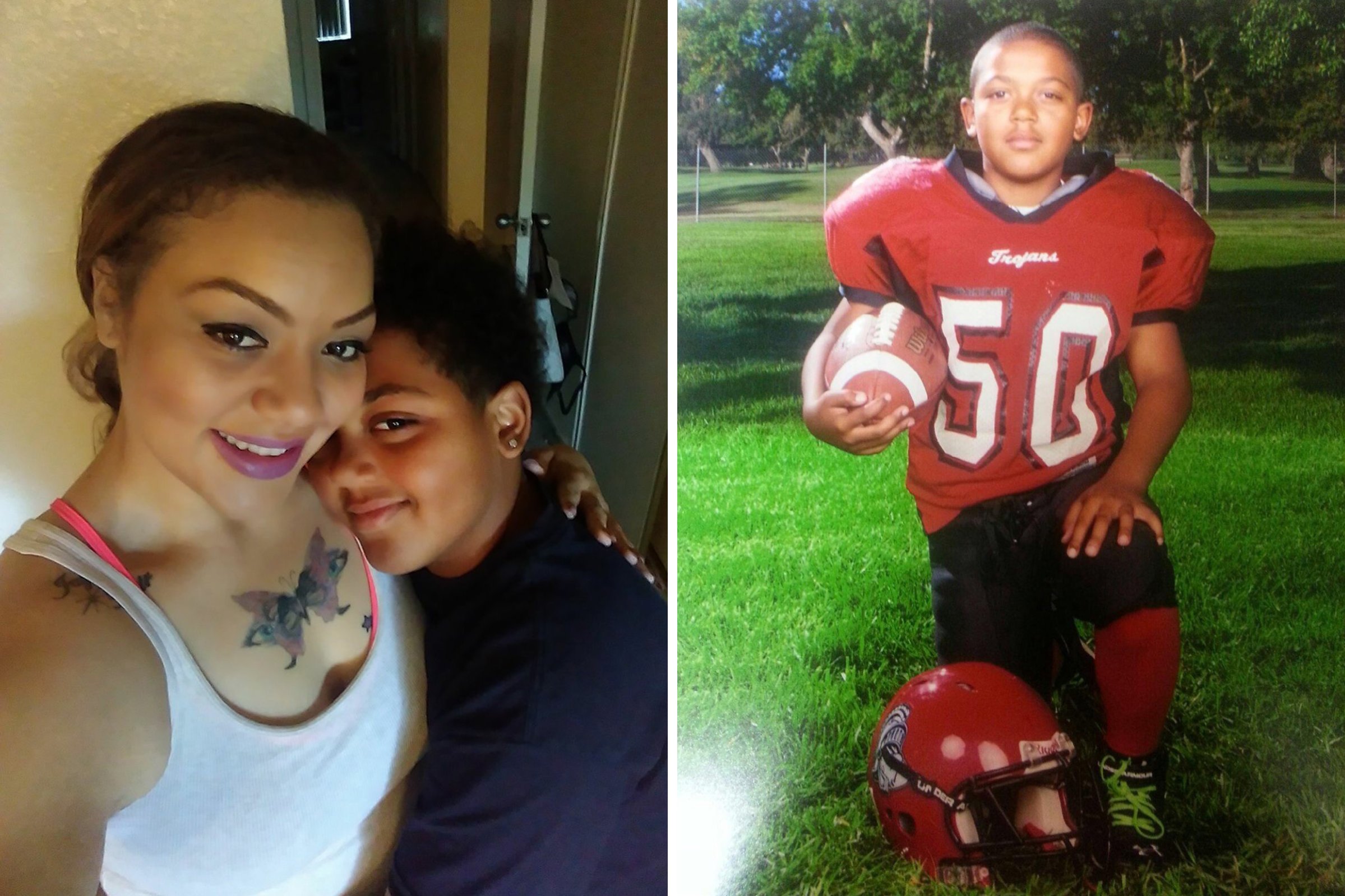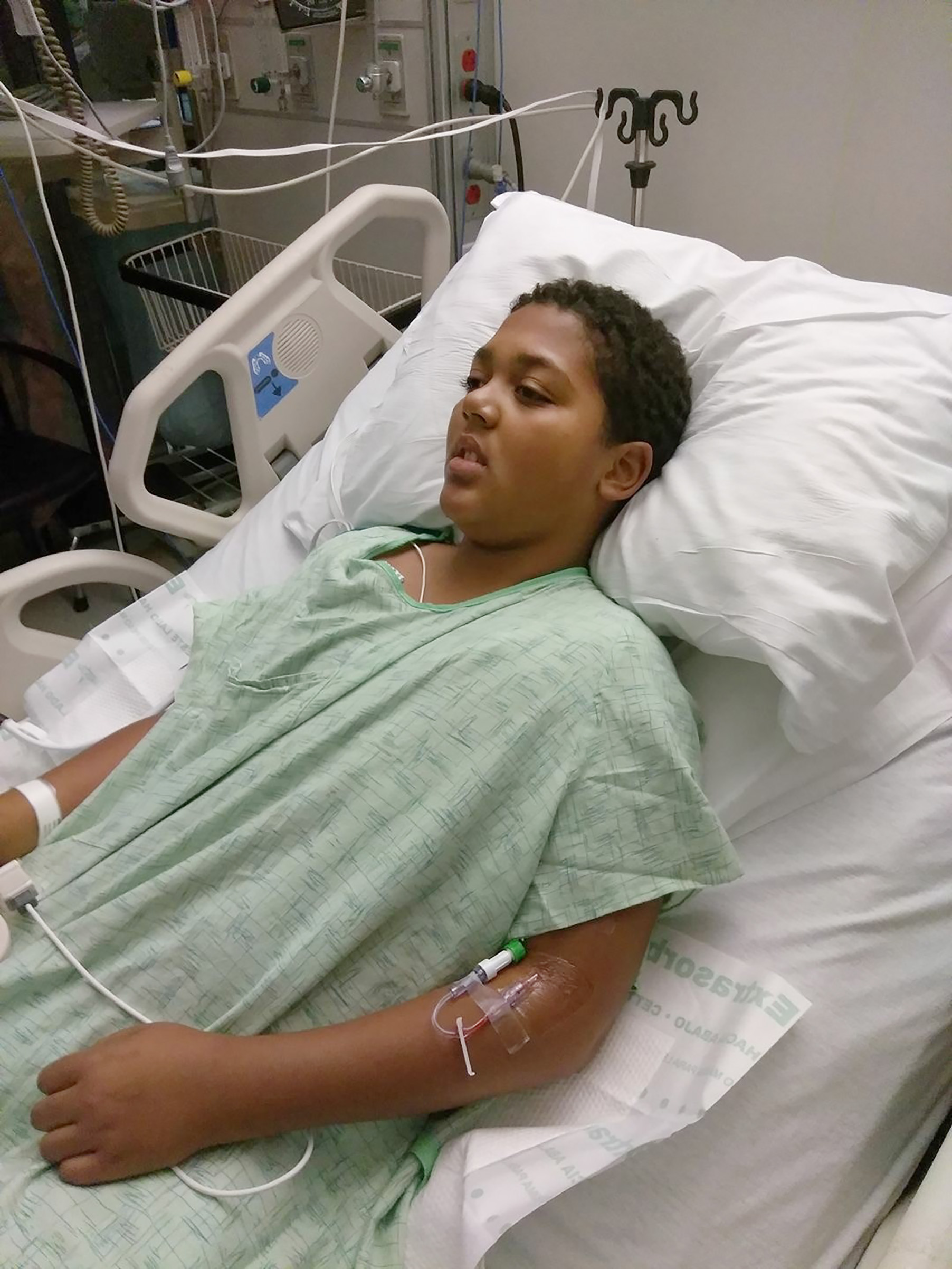
By mid-afternoon on August 1, 2017, the temperature in Stockton, Calif. was at least 105 degrees. Thirteen-year-old Jayden Galbert complained to his mother, Shynelle Jones, about the heat, but didn’t want to skip preseason football practice and hurt his chances of making the freshman football team. Instead, he showed up, pushed himself to participate, and then collapsed on the field. “He started vomiting and he was shaking,” Jones says. “He couldn’t see. He was trying to focus, but he couldn’t.” Jayden was eventually airlifted to UC Davis Medical Center, where he was diagnosed with exertional heat stroke, which in turn led to rhabdomyolysis, a dangerous condition in which muscle breakdown can cause kidney damage. “His entire body was shutting down and I almost lost him,” Jones wrote on Facebook shortly afterwards.
At the time, California’s high schools were not required to follow national best practice standards for preventing and treating heat stroke — guidelines that include having cold water tubs on hand in case players overheat, among other cooling treatments. And they’re still not, according to a new study conducted by the Korey Stringer Institute at the University of Connecticut that ranks all 50 states and the District of Columbia on whether they’ve implemented key sports safety policies that can prevent serious injuries and deaths of high school athletes. California ranks nearly last on the list and hasn’t implemented any of the best practice policies for preventing heat stroke, but many other states also fared poorly.
The policies included in the study cover “the four Hs: head, heart, heat and hemoglobin,” which together account for 90% of all sport-related deaths, says Samantha Scarneo, vice president for sport safety at the Korey Stringer Institute. But these policies aren’t uniformly implemented, which leaves many of the nation’s high school athletes at risk as students head back to school. No one knows just how many student athletes have been hurt or died in each state due to the lack of implementation, because those numbers are not tracked.
“They’re not sitting back and waiting for a kid to die to make these changes."
In California alone, there were more than 808,000 high school sports participants during the 2017-2018 school year, according to information released earlier this month by the California Interscholastic Federation. The state has several important measures in place, like requiring automated external defibrillators (AEDs) for cases of sudden cardiac arrest, and detailed return-to-play policies for players who are diagnosed with a concussion. But California also has the dubious distinction of being the only state that doesn’t regulate athletics trainers in any way. Trainers are often the ones to make calls about pulling a kid off the field or prescribing treatment. Despite several past legislative attempts, “the biggest concern in California is that the state does not require athletics trainers to be licensed,” Scarneo says. “Without any type of knowledge of who they are and what their training is, it makes it really difficult to actually trust that they know what they’re doing.”
States can look to New Jersey as a role model, which ranked No. 1 in the study and which Scarneo called “one of the most proactive states in the nation.” New policies enacted in New Jersey in the past year require cold-water immersion tubs, detailed steps for return to play, and strength and conditioning limits throughout the year. “They’re not sitting back and waiting for a kid to die to make these changes,” Scarneo says.
Overall, 21 states have made improvements since 2017 on policies in the key areas of sudden cardiac arrest, traumatic head injuries, exertional heat stroke, appropriate medical presence at games and practices, and emergency preparedness, Scarneo says. However, no state has a perfect score: even New Jersey only received 79.03% (by comparison, California scored 26%).

One reason states vary so widely on student-athlete safety policies is that there isn’t one overall group that can require them. Unlike at the college level, where the National Collegiate Athletic Association oversees policies for its member schools, the National Federation of State High School Associations (the umbrella organization for the state high school associations) has no such authority. (Though there are still problems in college sports — the recent heat stroke death of Maryland offensive lineman Jordan McNair is under ongoing investigation. Five Division I football players have died of heat stroke since 2000.)
But at the high school level, adoption of the best practice guidelines is left to each individual state. Some policies are enacted by the state’s high school association and some by its legislature, with the decentralization of oversight leading to tremendous variation that often leaves out important best practices.
There is some hope: since concussions have become a focus of public concern, lawmakers jumped to action, and it’s making a difference. Every state now has some type of a concussion law, which generally requires concussion education, immediate removal from play if it’s suspected that a player has a concussion, and medical clearance before that athlete can play again. A study last fall found a significant drop in the number of repeat concussions after the laws had been in effect for a period of time.
There’s also research showing that state heat acclimatization policies work. A study released by the National Athletic Trainers’ Association in June found that high-school football players were 55 percent less likely to be diagnosed with exertional heat illness (which includes heat stroke as well as heat exhaustion and heat cramps) during the preseason in states with guidelines for this timeframe.
To evaluate each state’s sport safety policies, the Korey Stringer Institute used the best practice guidelines established in 2013 by a task force representing the nation’s leading medical and sports safety experts. The institute, named for the Minnesota Vikings player who died of heat stroke during training camp in 2001, was one; others included the National Athletic Trainers’ Association, American College of Sports Medicine, American College of Emergency Physicians, and the National Federation of State High School Associations.
“It is unacceptable to me that there are still high schools in the United States that don’t have AEDs and also unacceptable to me that there are high schools that don’t have a comprehensive emergency response plan for cardiac arrest on their campus,” says Dr. Jonathan Drezner, a co-author of the 2013 recommendations on behalf of the American Medical Society for Sports Medicine, who also directs the Center for Sports Cardiology and is a professor of family and sports medicine at the University of Washington.
The results of a recent study Drezner co-authored show that there were about 50 cases per year of sudden cardiac arrest in high school athletes between July 2014 and June 2016, although Drezner believes the actual number is likely higher. “School staff and coaches need regular (at least annual) reminders on where the AEDs are located, when to use them, and how to recognize sudden cardiac arrest,” he wrote in an email.
“It is unacceptable to me that there are still high schools in the United States that don’t have AEDs."
But another author of the 2013 best practices questioned whether ranking the states will be effective. Dr. Joel Brenner, medical director of the sports medicine program at Children’s Hospital of The King’s Daughters and an associate professor of pediatrics at Eastern Virginia Medical School, who co-authored the guidelines on behalf of the American Academy of Pediatrics, thinks it would be far better for each state to evaluate its own progress, given that circumstances and resources vary, instead of being rated and compared. “If the purpose is to see what’s being done and what’s not being done and help the states, I’m not sure a public ranking is going to be helpful,” says Brenner.
Also, he points out, there may be state policies that help protect players but aren’t reflected in the rankings, if they weren’t explicitly part of the 2013 best practice recommendations. For example, California has in-season limits on the number of full-contact football practices and a ban during the off-season, but didn’t receive points for these in KSI’s study.
Even though the rankings don’t represent the whole picture of what’s being done in each state, Drezner believes that requiring these policies at the state level is ultimately the right approach. “When we just raise awareness and we provide help and we do all of these other things, it doesn’t impact change enough,” he says. “For the state associations that have the authority to be decision makers, I think the ranking is working,” he says. “It’s pushing people to do more and come closer to the policy guidelines. We’re all working toward the same goal.”
In the meantime, there are often long-term impacts for athletes like Jayden. A year later, he still regularly goes to therapy for PTSD from the ordeal. And although he’s largely physically recovered, he still walks with a limp and has residual pain in his legs from the rhabdomyolysis he suffered. “Some days are better than others,” his mother says.
Jayden stopped playing football for the first time since he was 6 after the injury, but still hopes to play again at some point in high school. But after what he went through — and the environment Shynelle knows he’d be going back to — his mom has already made up her mind that the answer is no.
More Must-Reads From TIME
- The 100 Most Influential People of 2024
- The Revolution of Yulia Navalnaya
- 6 Compliments That Land Every Time
- What's the Deal With the Bitcoin Halving?
- If You're Dating Right Now , You're Brave: Column
- The AI That Could Heal a Divided Internet
- Fallout Is a Brilliant Model for the Future of Video Game Adaptations
- Want Weekly Recs on What to Watch, Read, and More? Sign Up for Worth Your Time
Contact us at letters@time.com